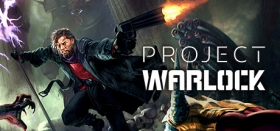
Project Warlock Review
Quick! Take a look at a screenshot on this page, any one will do. Tell me, what game are you looking at? Doom? Well you’d be forgiven for thinking so, but no; this is Project Warlock, a retro-inspired first-person shooter from (the superbly named) Buckshot Software that could only be more '90s if it took about two weeks to download and hid a few Spice Girls hits throughout its soundtrack. Thankfully, neither of these things are true. While it does take VERY strong influence from the “Dooms” and “Duke Nukems” of this world, it’d be unfair to label Project Warlock as a mere copycat. Instead of mindlessly imitating the retro shooters of yesteryear, the developer has worked to keep what makes those classics timeless while adding a little modern flair of its own exactly where the 90s rust is starting to show.

I could write a description of Project Warlock’s core gameplay here… or, I could copy-paste a description of the original Doom’s—you wouldn’t be able to tell either way. That is to say that the two games are near identical in terms of moment-to-moment gameplay. Maze-like, secret-filled maps brimming with demons—some flying, some giant, some with projectile attacks—and one person (you) who must kill ‘em all with an assortment of heavy weaponry. There’s also a little portrait of a nameless man at the bottom of the screen who gets progressively more bloodied as the player’s health dwindles. Oh, and the only semblance of story comes in the form of self-indulgently angst ridden ending screens for every chapter. You see? Is this Doom, or is it Project Warlock? You’ll never know.
Okay, joking aside; there ARE some crucial differences that would make Project Warlock stand out from the game lineup of a typical MS-DOS system. Should you have followed my earlier request to look at one of the screenshots on this page, you’d have noticed a subtle progress bar at the bottom of the screen. That—surprisingly—is an XP bar. You heard correctly; there are RPG mechanics in this retro-shooter—don’t worry, not particularly deep ones. Each weapon offers the choice between two one-off upgrades which affect its performance (fast-firing but weak, or sluggish but powerful—that sort of thing). Additionally, levelling up rewards players with better pickups, increased health, ammo capacity, mana and more. Wait, did I say “mana”? Yep, Project Warlock has just one more trick up its innovation sleeve: spellcasting.

Project Warlock’s nameless protagonist unlocks a variety of offensive and defensive spells on his demon-hunting conquest: Orbs of lightning, ice blasts, protective shields and more. Earlier levels can be breezed through with firearms alone, but tackling the hordes that characterise later stages will require effective spellcasting AND swift shooting. These departures from the norms of 90s shooters give the game enough of a unique identity while remaining unobtrusive enough to keep the focus on what’s most important: the shooting.
And what fun the shooting is. Game designers talk of evoking the mythical “flow state” in players—the point where they’re completely mentally engrossed in the game’s rhythm and actions—and, for me, Project Warlock was a one-way ticket to sinking straight into that flow state. Apparently there are 60-odd levels in Project Warlock, but that’s a statement I can neither confirm nor deny. The whole six or seven-hour experience passed by in a glorious haze of bloodshed, lightning bolts and explosions. Nothing outside the confines of my TV mattered and level changes went by almost unnoticed. There could be 60 levels, or there could be 600. All I know is I enjoyed every last one of them.

Of course, this isn’t meant to imply that the stages are all the same; there are actually five distinct aesthetic styles wheeled out over the course of the game (on top of the overarching ‘Doom Engine’ aesthetic). It seems demons have an interest in history because, in addition to an Arctic base, Doom-style hellscapes and a modern day setting (the OTHER hellscape), Project Warlock also visits ancient Egypt and Medieval Europe. An eclectic mix of locations, indeed. And each location brings a unique variant of each enemy type and pickup. The game probably wouldn’t have gotten stale even without this variation, but Buckshot Games really deserves commendation for going the extra mile here.

One oversight in the level design can’t go unmentioned. It’s possible (and annoyingly easy) to trap yourself in levels by activating a lift and immediately ‘backing out’. I often backpedaled after pressing a button, expecting an enemy ambush, only to find that I’d activated a one-way lift that was ascending without me. These occurrences prompted level restarts which, at most, was a setback of a few minutes—hardly a game-breaker.
Project Warlock wears its 90s first-person shooter influence on its sleeve, even going so far as to hide loving easter egg homages throughout. It’s fast, violent and perfectly paced—a must play, whether you harbour fond memories of its inspiration or not. Besides some minor setbacks caused by level design quirks, Project Warlock was pure, unadulterated fun from start to finish.
Project Warlock (Reviewed on Xbox One X)
Excellent. Look out for this one.
Project Warlock wears its 90s first-person shooter influence on its sleeve. It’s fast, violent and perfectly paced—a must play, whether you harbour fond memories of its inspiration or not. Besides some minor setbacks caused by level design quirks, Project Warlock was pure, unadulterated fun from start to finish.






COMMENTS